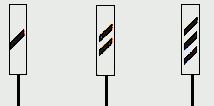 |  |
Below, some of the signals of the Luxemburg railways are explained. As with most railways the colors are the same, red for danger, green for safe and yellow for pre-warning for unsafe conditions. The shape of the signals of Luxemburg resembles the signals in France.
This is the normal signal as placed on lines and on yards. Four lights, in a vertical row below each other.

Red light (the third light from the top), burning continually.
Meaning: Stop. This light is placed at the beginning of a block (on lines), or before unsafe places like points or on yards.

Green light (the second light from the top), burning continually.
Meaning: The block after the signal is free. Passing is allowed with a speed as indicated as maximum speed for the line.

Two yellow lights (the top light and the bottom light), burning continually.
Meaning: The block after the signal is free, but passing of the signal is only allowed with a speed of maximum 30 km/h. This is a situation when a train is coming into a station, where points must be passed in a lower speed as should be the maximum speed for the line.
This signal is placed some meters before a main signal. Normally the distance is 400 to 1100 meters. This distance is depending of the maximum speed of the line. When the maximum speed of a line is less than 50 km/h, then the advance signal is omitted.
The idea of it is, that a driver of a train only needs to see signals when he is passing them. This signal can indicate, that it is unsafe to pass a coming main signal with a high speed.
The shape is quadrangular, two lights besides each other, and two lights below each other.

Yellow light (the left top light), burning continually.
Meaning: The next main signal will show red, so the driver will need to slow down the speed and stop before the next main signal.

Green light (the left below light), burning continually.
Meaning: The next main signal will show green, so the driver is allowed to keep driving with the maximum speed of the line.

Two yellow lights (the two top lights), burning continually.
Meaning: The next main signal will show two yellow lights, so it is safe to pass the next main signal, but with restricted speed of 30 km/h. The driver will need to slow down until that speed.
These shields are placed several meters before a main signal. The driver knows then what speed to ride before stopping at a signal. The left shield (with one band) is placed 100 meters before the signal, the middle shield (two bands) 175 meters, and the right shield (three bands) at 250 meters before the signal.
Both signals as shown here are possible. The height depends on local situations.


This signal is placed at special places. They indicate a place until where a train may proceed, if no other signal is available. Which of the two (horizontal or vertical) shapes is placed, is depending on the local situation.
There are 3 situations in which the signal is placed:


Purple light (the bottom or the left light), burning continually.
Meaning: Stop before the signal.


White light (the top or the right light), burning continually.
Meaning: It is safe to proceed (at slow speed) after the signal.
This is a mobile signal, placed by hand between the two rails of a track.
It is placed in special places, when no other (fixed) signal is available, when a train needs to stop (like in Luxemburg central station on long tracks, when another train is standing and the second train needs to halt on a specific place).

A metal plate in the form of a red square.
Meaning: Stop before the signal.

A metal plate in the form of a yellow circle.
Meaning: It is safe to proceed (at slow speed) after the signal (this signal is often omitted, as this is the normal situation on a track).
The line from Luxemburg city to Arlon and Brussels is electrified with 3000 Volt DC. The rest of the lines in the country are electrified with 25 kV 50 Hz. In the station of Luxemburg city these two systems meet. On track number 3 and 4 of this station, it is possible to switch the catenary between both systems.
As it would be a serious problem when an electric locomotive should be fed by the wrong voltage, there are special signals to indicate whether it is safe to proceed for an electric locomotive.
In near future the line from Luxemburg to Kleinbettingen will be changed to 25 kV alternate current. From then on, in Luxemburg the situation will change, the double voltage tracks will no longer be necessary.

Violet light (the top light), burning on and off.
Meaning: It is UN-safe for electric trains to proceed.
This is a additional signal, not combined with another main or advance signal.

White light (the bottom light), burning on and off.
Meaning: It is safe to proceed for electric trains.
This is a additional signal, not combined with another main or advance signal.

Yellow light (the top right light), burning on and off.
Meaning: It is UN-safe for electric trains to proceed at the next main signal.
In this situation, the signal is combined with an advance signal. It only functions, when the next main signal is showing free right of way.

White light (the bottom left light), burning on and off.
Meaning: It is safe to proceed for electric trains at the next main signal.
In this situation, the signal is combined with an advance signal. It only functions, when the next main signal is showing free right of way.